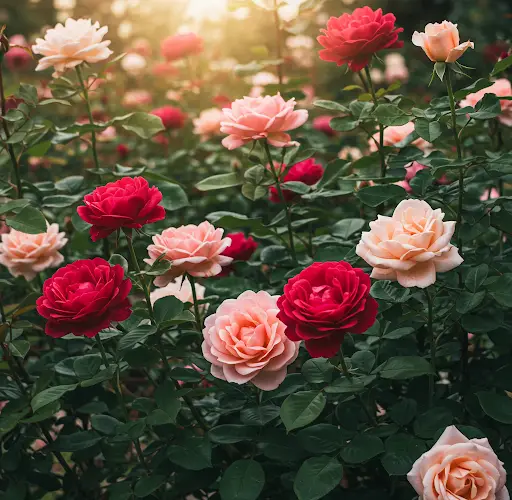How to Grow Roses for Beginners | Garden Ideas
Roses are one of the most beautiful and beloved flowers in the world, known for their enchanting fragrance and stunning blooms. Growing roses may seem intimidating for beginners, but with the right approach, anyone can cultivate a thriving rose garden. Whether you want to grow roses in your backyard, balcony, or containers, this guide will walk you through the essential steps to successfully plant and care for roses.
Why Grow Roses?
Roses are not just aesthetically pleasing; they also provide several benefits:
✅ Attract Pollinators – Bees and butterflies love roses, promoting biodiversity in your garden. ✅ Fragrant and Beautiful – Their scent and vibrant colors enhance any landscape. ✅ Versatile Planting Options – Can be grown in gardens, pots, or even as climbing vines. ✅ Symbolic Meaning – Roses represent love, passion, and beauty. ✅ Low Maintenance – Once established, roses require minimal care.
Choosing the Right Rose Variety
Roses come in different types, so selecting the right variety is essential for beginners. Some popular and easy-to-grow varieties include:
🌹 Hybrid Tea Roses – Classic long-stem roses, ideal for cutting and arrangements. 🌹 Floribunda Roses – Compact, bushy roses that bloom in clusters. 🌹 Climbing Roses – Perfect for trellises, fences, and archways. 🌹 Miniature Roses – Small-sized roses suitable for pots and balconies. 🌹 Shrub Roses – Hardy and disease-resistant, great for low-maintenance gardens.
Best Time to Plant Roses
Roses can be planted in either spring or fall, depending on your climate.
- 🌱 Spring (March to May): Ideal for areas with cold winters, giving roses time to establish before summer.
- 🍂 Fall (September to November): Suitable for mild climates where winters are not harsh.
Step-by-Step Guide to Growing Roses
Step 1: Selecting the Right Location
🌞 Choose a Sunny Spot – Roses require at least 6-8 hours of direct sunlight per day. 🌱 Ensure Good Air Circulation – This prevents fungal diseases and promotes healthy growth. 🌿 Avoid Crowded Spaces – Roses need room to spread their roots and branches.
Step 2: Preparing the Soil
🌎 Well-Draining Soil – Roses prefer loamy, well-draining soil with a pH between 6.0-6.5. 🌱 Enrich with Compost – Mix organic compost, aged manure, or peat moss for better nutrition. 💧 Ensure Moisture Retention – Adding mulch around the base helps retain soil moisture.
Step 3: Planting Roses
1️⃣ Dig a Hole – The hole should be twice as wide and deep as the root ball. 2️⃣ Soak the Roots – If planting bare-root roses, soak them in water for a few hours before planting. 3️⃣ Place the Rose Bush – Position the rose so that the bud union (the swollen part where branches start) is slightly above soil level. 4️⃣ Backfill with Soil – Gently cover the roots, firming the soil around them. 5️⃣ Water Thoroughly – Give the newly planted rose a deep watering.
Caring for Roses
1. Watering
💧 Deep and Regular Watering – Water 2-3 times a week, ensuring moist soil but not waterlogged. ⏰ Morning Watering – Water early in the day to prevent fungal diseases.
2. Fertilizing
🌱 Balanced Fertilizer – Use a slow-release fertilizer or organic options like banana peels, coffee grounds, or fish emulsion. 📅 Fertilizing Schedule – Feed roses every 4-6 weeks during the growing season (spring to fall).
3. Pruning and Deadheading
✂️ Remove Dead or Weak Stems – This encourages new growth and prevents disease. 🌺 Deadhead Spent Blooms – Trim faded flowers to promote continuous blooming. 🌿 Annual Pruning – In early spring, cut back one-third of the plant for healthier blooms.
4. Mulching
🌿 Retain Moisture – Apply 2-3 inches of mulch around the base to reduce evaporation. 🌾 Suppress Weeds – Mulch prevents weeds from competing with your roses for nutrients.
5. Protecting from Pests and Diseases
🐞 Common Pests: Aphids, spider mites, and Japanese beetles can attack roses. 🦠 Diseases to Watch For: Black spot, powdery mildew, and rust. ✅ Natural Remedies: Use neem oil, insecticidal soap, or a homemade garlic spray to keep pests away.
Growing Roses in Containers
If you have limited space, growing roses in containers is a great option:
🌿 Choose a Large Pot – At least 12-16 inches wide with drainage holes. 🌱 Use High-Quality Potting Mix – Ensure it contains compost and perlite for good drainage. 💧 Water More Frequently – Potted roses dry out faster than those in the ground. 📍 Place in Full Sun – Keep pots in a sunny location for best results.
Best Companion Plants for Roses
Pairing roses with other plants enhances garden beauty and deters pests:
🌼 Lavender – Deters aphids and attracts pollinators. 🧄 Garlic & Chives – Repels rose pests naturally. 🌿 Marigolds – Prevents nematodes and other harmful insects. 🌾 Sage & Thyme – Improves soil health and repels bugs.
Common Problems and Solutions
🛑 Yellowing Leaves? – Check for overwatering, poor drainage, or lack of nutrients. 🛑 No Blooms? – Your rose might need more sunlight or proper pruning. 🛑 Drooping Leaves? – This could be due to underwatering or heat stress. 🛑 Spotted Leaves? – Likely a fungal disease; apply an organic fungicide.
Conclusion
Growing roses is a rewarding experience that adds timeless beauty to your garden. With proper care, the right variety, and essential gardening techniques, even beginners can cultivate a flourishing rose garden. Whether you choose to plant them in the ground or in containers, roses will reward you with their delightful fragrance and stunning blooms for years to come.
Start your rose gardening journey today, and enjoy the beauty of these timeless flowers! 🌹🌿✨
Happy Gardening! 🌸🌱



